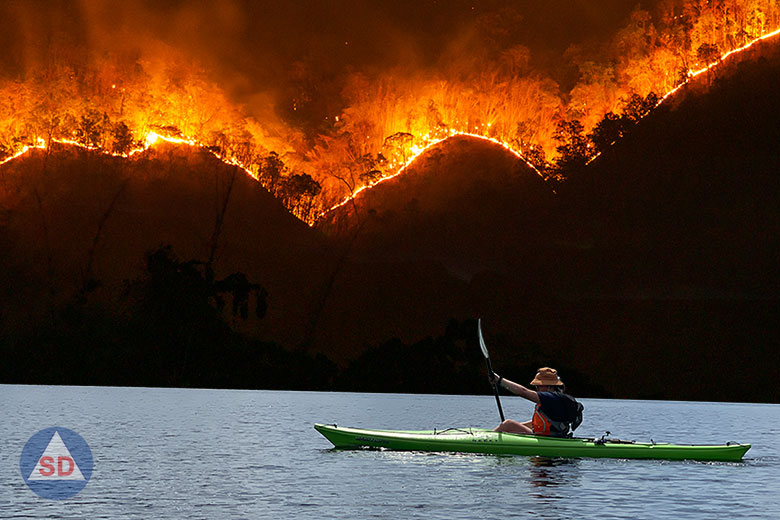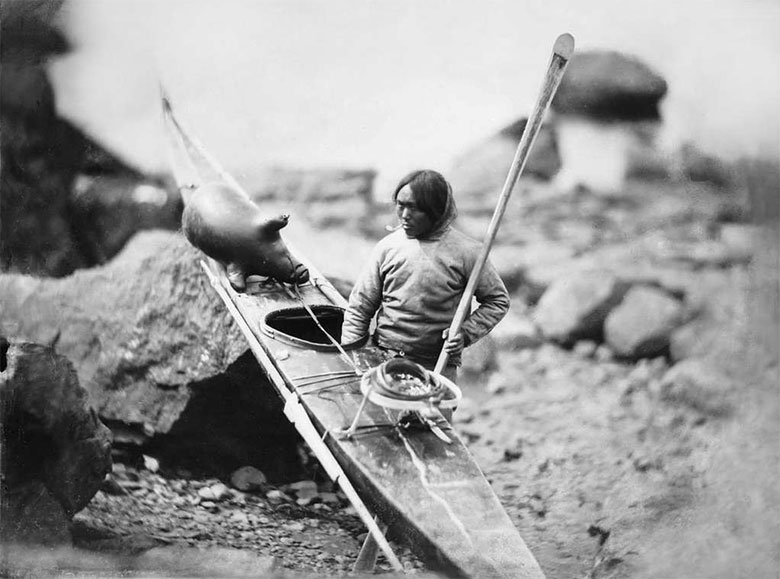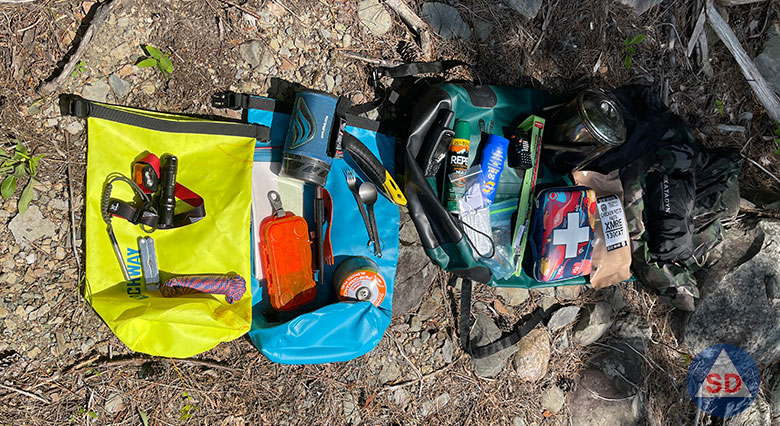
Picture this: a crisis strikes your city, chaos engulfs the streets, and traditional bug out routes are nothing but an endless sea of traffic. How do you escape the turmoil and secure your safety?
A kayak bug out is not often discussed in prepper circles and I’m not sure why. Kayaks are an unconventional bug out vehicle, for sure, but in the right situation they can offer a rapid escape from a dangerous situation. Everyone thinks about their car or truck, but when a crisis strikes, roads and highways quickly become jammed with traffic. Vehicles hit a standstill.
Kayaks can help you escape more quickly if you live near a river, lake, or ocean.
With a kayak, you can rise above the turmoil and access remote areas that others can’t reach. A kayak can become the life boat in a sea of chaos (excuse the puns), much in the same way a bug out canoe can.
Historical Significance of Waterways and Kayaks
Throughout history, civilizations flourished around waterways, and for good reason. Rivers, lakes, and coastlines provided the means for transportation, trade, and sustenance. This is precisely why large towns and cities are almost always located along the coast, rivers, or large lakes. For that reason, a large percentage of the population is near navigable water – precisely why a kayak bug out should be considered as an alternate, if not primary, bug out strategy.
In the early days, water served as a lifeline, facilitating transportation for goods and people. It allowed for trade to flourish, connecting distant communities, and fostering cultural exchange. Waterways were the highways of the past, enabling the growth of mighty empires and bustling trade hubs.
Moreover, water offered a reliable source of sustenance. Fishing provided communities with a steady supply of food, while fertile lands near rivers and lakes supported agriculture. The close relationship between humans and water instilled a profound respect for these natural resources.
As time went on, humans developed ingenious ways to navigate these waterways, creating various types of watercraft to suit their needs. And one of the most remarkable among them—the kayak—has stood the test of time.
The kayak, originally used by indigenous peoples in Arctic regions, was an ingenious invention designed for survival and transportation. These lightweight and maneuverable vessels allowed them to navigate icy waters and reach places that larger boats couldn’t access.

Today, we’ve taken this ancient concept and adapted it to modern times. Kayaking has evolved into a popular recreational activity, but it also holds incredible potential as a survival tool during crises.
History has shown us that when chaos strikes, highways can become traps. But by returning to our roots and embracing the kayak, we gain a unique advantage—the ability to escape and survive when others are stuck in the chaos.
Kayak Bug Out Crisis Scenarios
Life is unpredictable, and when crisis strikes, it can catch us off guard. Whether it’s a natural disaster, civil unrest, or any other possible SHTF event, sometimes staying put is not the safest option. That’s where bugging out becomes a crucial survival strategy.
Crises can escalate rapidly, leaving us with little time to make life-saving decisions. When the situation becomes dire, bugging out becomes a prudent choice—a strategic retreat to a safer location.
But let’s be clear: Bugging out doesn’t mean running away out of fear. It’s a calculated response to preserve your well-being and that of your loved ones. You must be informed, prepared, and equipped to execute your bug out plan effectively.
So, when might bugging out become necessary? Well, consider some crisis scenarios where a bug out strategy could be a game-changer.
- Natural Disasters – Mother Nature can be relentless, and when a powerful hurricane, flood, or wildfire strikes, it can quickly turn areas into danger zones. In such situations, evacuating to higher ground or safer regions becomes paramount.
- Civil Unrest – Civil unrest can erupt unexpectedly due to various factors, and it can lead to violence and widespread disruptions. During such events, you may need to swiftly evacuate to protect yourself from harm.
- Infrastructure Breakdown – Infrastructure breakdowns, like power outages or building collapses, can leave urban centers paralyzed. If staying becomes untenable, having a bug out plan with a reliable escape route can be a lifesaver.
Ultimately, bugging out via kayak provides an alternative escape route—one that allows you to bypass road congestion and access areas inaccessible to vehicles. But remember, planning ahead and staying informed are vital to executing a successful bug out.
Stay vigilant and monitor local authorities’ guidance during a crisis. Develop a comprehensive bug out plan that includes a designated meeting point for your family or group, pre-selected evacuation routes, and contingency plans for various scenarios.
Advantages of Bugging Out by Kayak
Let’s dive into the advantages of using a kayak for evacuation, because there are more than most people think!
- Agile and Stealthy Movement – A kayak’s greatest strength lies in its agility and stealth. Unlike larger boats or vehicles, kayaks can navigate through tight spots, shallow waters, and narrow channels with ease. This ability allows you to avoid congested roads and reach destinations that might be off-limits to other modes of transportation.
- Access to Remote Areas – Think about it—in a crisis, everyone else might be trying to escape through the same routes. But with a kayak, you can take a less-traveled path. Remote waterways, hidden coves, and small islands become accessible havens, offering safety and seclusion.
- Self-Sufficiency – Your bug out kayak can be your self-sufficient survival capsule. With proper planning and packing, you can carry essential supplies and gear to sustain yourself for an extended period. It’s like having your emergency kit on the water—a compact and efficient solution.
- Limited Dependency on Infrastructure – During crises, infrastructures like roads, bridges, and public transportation may become unreliable or even unusable. But with a kayak, you’re not dependent on such infrastructure. Your bug out route lies on the water, free from traffic jams and obstructions.
- Stealth Camping – When bugging out via kayak, you can utilize stealth camping techniques. Find hidden spots along the shoreline or small islands to set up camp. This low-profile approach helps you stay inconspicuous and ensures your safety throughout the journey.
- Reduced Encounters with Others – In a crisis, encounters with others might be unpredictable. By choosing a waterway route, you can reduce the chances of unexpected interactions and maintain a lower profile. It allows you to focus on your safety and escape, minimizing potential risks.
Remember, the key to successfully using a bug out kayak is preparation and practice. Familiarize yourself with the kayak, build your paddling skills, and test your bug out route before an emergency strikes.
Kayak Bug Out Gear List

In the video I embedded above, you can see me go through my kayak bug out gear. I am also detailing the list below, and if you want, you can download the entire list below to print for reference.
Download My Bug Out Kayak Gear List
The gear is listed in alphabetical order. What works for me may not work for you, so use my list as a guide and customize your kit to meet your situation. Stay mindful that this is primarily gear chosen for a freshwater kayak bug out. If you plan to bug out over salt water, your list will likely include some other items.
Your bug out kayak is your lifeline, and with these carefully selected items, you’ll be well-prepared to handle various survival challenges. Regularly review and update your kayak bug out kit, ensuring that everything remains in good condition and within the expiry dates. Adjust it to fit the seasons.
Remember, the goal is to be self-sufficient during at least a three-day bug out period. Prioritize the essentials and avoid unnecessary items that may weigh you down. Keep your bug out kayak organized and accessible, so you can quickly access what you need when you need it.
Redundancy is also something that you should aim for. In prepping, two is one and one is none. It is too easy for something to break or fail. You need redundancy to account for gear failure, losing an item, etc. This is a concept you should use in all your preps, not just bug out gear.
- Aquaquest Tarp – A tarp is a versatile tool in any bug out situation, but even more so in a kayak bug out kit. It can provide protection from the elements, cover your gear, create a shelter, or help hide your kayaks. I love the Aquaquest tarp because it’s a mission-built tarp. It’s designed for preppers. If cost is a concern, a cheaper tarp will do, but the Aquaquest tarp has more attachment points, stronger stitching, and better overall quality. I covered this tarp in more detail in my Tarp vs Tent article.
- Backpacking Stove – Backpacking stoves are perfect for a kayak bug out because they’re compact and lightweight. I use the Jetboil because it’s so convenient, but another option is the MSR Whisperlite, which I’d used for many years prior to the Jetboil.
- Bic Lighter – Simple and cheap. Pack a few.
- Billy Pot – These are a bushcraft basic, a simple stainless steel pot that can hang over an open fire. You can boil water (purify it) and cook food. You can also store food and gear in it to conserve space. If cost is a concern, just cut out a large tin can and add a wire handle, like the hobos did.
- Boonie Hat – You need a hat that will keep the sun out of your eyes and off your face and neck. A regular sun hat can work, but I like the boonie-style hat because it also keeps a bug net away from my face.
- Bug Net – Biting insects might not be an issue where you’re at, but bug nets are so compact, cheap, and lightweight that I have one in every bug out bag and vehicle.
- Bushcraft Knife – You need a good, fixed blade knife, and a strong fixed blade usually means a bushcraft knife. Need advice? See my video on the best bushcraft knife.
- Caffeine Pills – Bugging out may require you to push your body beyond its normal limits. Caffeine pills can give you the energy needed to keep moving.
- Cellphone – This probably doesn’t even need to be on the list as most people never leave the house without one. Their value cannot be understated, however. The modern cellphone is much more than just a telephone. It’s a small computer in your hand that can hold contact information, maps, digital files, etc.
- Clothes – Quick drying is the key here. Oh, and don’t forget extra socks!
- Emergency Whistle – Odds are being found is the last thing you want in a bug out, but you can’t take chances on the water. A whistle is louder and takes a lot less effort than hollering. They’re cheap, tiny, and weigh almost nothing. Every member of your party should have one.
- Extra Batteries – Obviously.
- Ferro Rod – A Ferro rod can start countless fires. One note: practice using one in advance. There’s more to making a fire with a Ferro rod than just striking it with steel. Know the basics of starting a fire in the outdoors.
- First Aid Kit – This is another “no duh” item. Don’t forget personal prescription drugs.
- Food – The traditional bug out bag is designed for 3 days. Focus on calorie-dense foods. Freeze-dried packaged foods and MREs are great choices. Their packaging is also waterproof. Energy bars are also good.
- Handheld GPS – A map and compass are foolproof. A handheld GPS is fast, convenient, and effective. Carry both.
- Handheld Radio – I use the Baofeng UV-5R radio with upgraded antenna. It’s a popular radio with preppers for good reason. It’s cheap enough that everyone in your party should carry one.
- Headlamp – I use the Petzl ACTIK CORE because I use mine every day and I don’t want to keep replacing batteries. It’s rechargeable, but also takes AAA batteries. I like the option to either recharge the light or use batteries.
- Map and Compass – Ideally you know how to use a map and compass for navigation, but even without in-depth land navigation knowledge, they can still be used by a novice to aid navigation. I treat my maps with a waterproofing product to help keep them safe in wet environments.
- Multi-tool – These are necessary in any bug out bag.
- Paracord – Preppers know the value of Paracord.
- PFD and Paddle – Don’t skimp on quality or comfort.
- Tactical Light – I carry the Olight Odin Mini. I like it because it’s powerful and rechargeable, but the downside is it doesn’t take external batteries, so you need a means to recharge it in the field.
- Toilet Paper – It’s better than using leaves.
- Pack Saw – This might be optional for some people, but I like it in addition to a bushcraft knife. It’s great for gathering firewood or other bushcraft uses like fixing your shelter.
- Sunscreen – You don’t want to deal with a severe sunburn on day one.
- Utensils – Focus on lightweight here. Buy a cheap but durable fork/spoon combo or some titanium utensils.
- Water Filter – This is a must. I use the Katadyn Vario. It’s reliable and pumps out a lot of clean water in a short amount of time. It’s great for a group of people, but there are cheaper options such as the Water Straw.
- Water Knife – By “water knife” I mostly mean a diving-style knife, one that allows quick access while in the water in case you need to cut something (often straps or rope) but doesn’t have the point that could cause accidental harm. I strap mine to my PFD.
Additional Kayak Bug Out Tips
- Pre-plan and Rehearse Your Route: The key to a smooth bug out is proper planning. Study your area’s waterways and identify potential routes that lead to safer locations. Have alternative routes in mind in case certain paths become blocked or unsafe. Rehearse your bug out route in calm conditions to familiarize yourself with the journey.
- Practice Paddling and Basic Kayak Skills: Kayaking might seem straightforward, but paddling efficiently requires practice. Spend time paddling on calm waters to build your skills and confidence. Learn how to maneuver, perform turns, and maintain stability, so you’re prepared for any challenges during your bug out journey.
- Perform Regular Maintenance Checks: Regularly inspect your bug out kayak and gear. Check for any signs of wear and tear, and promptly address any issues. Ensure that all compartments are watertight and test your communication devices and navigation tools to guarantee they’re in working order.
- Organize Your Bug Out Kayak: An organized bug out kayak can save you valuable time during an emergency. Keep your essential items in easily accessible compartments. Use dry bags or waterproof containers to protect gear from water. Practice loading and unloading your kayak efficiently to optimize your bug out process.
- Stay Informed and Updated: Stay informed about local weather conditions, emergency alerts, and potential hazards. Being aware of the situation in real-time can help you make better decisions during your bug out. Keep a weather radio or a reliable communication device handy to stay updated.
- Involve Your Bug Out Group: If you’re bugging out with a group or family, involve them in the planning process. Discuss the bug out strategy, roles, and responsibilities. Ensure that everyone knows how to use the kayak and understands the evacuation plan in case you get separated.
By preparing in advance and following these practical tips, you’ll be ready to embark on your kayak bug out with confidence. Remember, practice makes perfect, so make kayaking a regular part of your outdoor routine. Stay prepared and vigilant, and you’ll be well-equipped to face any challenges that come your way.
2 comments
I can’t store a kayak. what are the pros and cons of following the main rail line out of the city?
Pro: Easy to walk and you know where it goes. Con: Others will think the same thing.